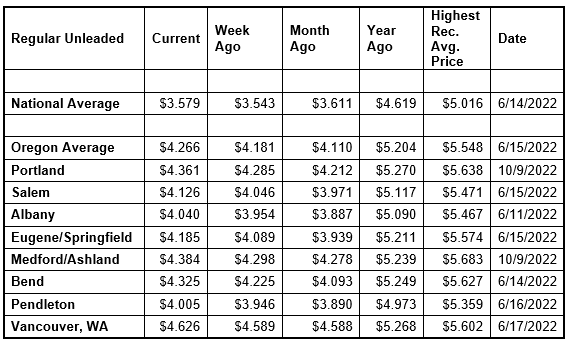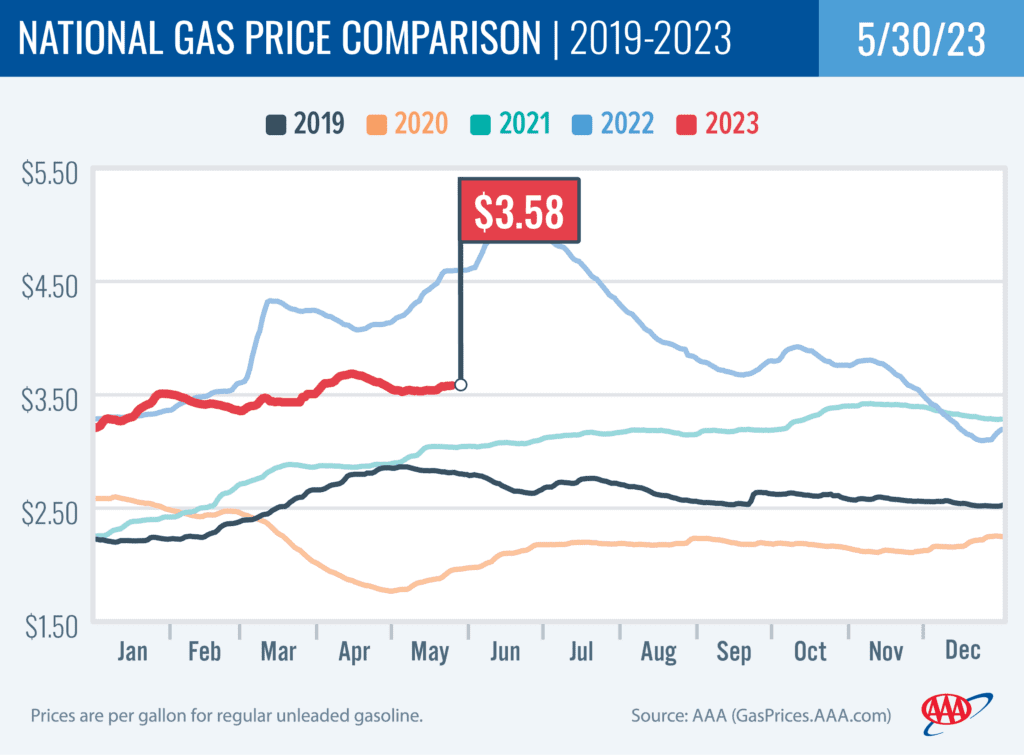PORTLAND, Ore., – The seasonal surge in gasoline demand ahead of the Memorial Day weekend sent pump prices climbing as drivers fueled up for holiday road trips. The deal to raise the nation’s debt ceiling may also bring a rally in oil and gas prices. Still, drivers are saving about a dollar a gallon compared to last year when pump prices skyrocketed above $5. For the week, the national average for regular rises four cents to $3.58 a gallon. The Oregon average adds eight cents to $4.27.

“An increase in demand for gas and a drop in gasoline stocks in the U.S. have put upward pressure on pump prices. Increases are mitigated by relatively low crude oil prices which remain below $75 per barrel. Pump prices should stabilize or even tick lower in the coming weeks,” says Marie Dodds, public affairs director for AAA Oregon/Idaho. “Factors that could push pump prices higher this summer are refinery issues, hurricanes, or major economic or geo-political events.”
OPEC+ is holding its next meeting June 4 in Vienna. At its April meeting, the Organization of the Petroleum Exporting Countries and other major oil producers, including Russia, known collectively as OPEC+, announced that the cartel would cut oil production by just over 1 million b/d through the end of 2023. The news sent oil prices above $80 per barrel, but then crude fell below $80 on April 19 on economic concerns and has remained below $75 per barrel since May 2.
Crude oil is trading around $70 today compared to $73 a week ago and $115 a year ago. In April, West Texas Intermediate ranged between about $73 and $83. In March, WTI ranged between about $64 and $81 per barrel. In February, WTI ranged between about $73 and $80 per barrel. In January, WTI ranged between about $73 and $82 bbl. Crude reached recent highs of $123.70 on March 8, 2022, shortly after the Russian invasion of Ukraine, and $122.11 per barrel on June 8, 2022. The all-time high for WTI crude oil is $147.27 in July 2008.
Crude oil is the main ingredient in gasoline and diesel, so pump prices are impacted by crude prices on the global markets. On average, about 56% of what we pay for in a gallon of gasoline is for the price of crude oil, 20% is refining, 11% distribution and marketing, and 14% are taxes, according to the U.S. Energy Information Administration.
Demand for gasoline in the U.S. demand increased from 8.91 to 9.43 million b/d for the week ending May 19. Rising demand has helped to boost pump prices. This compares to 8.80 million b/d a year ago. Meanwhile, total domestic gasoline stocks decreased by 2 million bbl to 216.3 million bbl. If gas demand grows amid tighter supplies, drivers will likely see pump prices rise.
Quick stats
Oregon is one of 41 states and the District of Columbia with higher prices now than a week ago, and 46 states and D.C. saw prices change by a dime or less in the last week. New Jersey (+14 cents) has the largest weekly increase. Arizona (-9 cents) has the largest weekly decline. The averages in Kentucky and Georgia are flat.
California ($4.86) has the most expensive gas in the nation for the 13th week in a row. Hawaii ($4.74) is second, Washington ($4.69) is third, Arizona ($4.52) is fourth, Nevada ($4.28) is fifth, Oregon ($4.27) is sixth, and Utah ($4.07) is seventh. These are the seven states with averages at or above $4 a gallon. This week 42 states and the District of Columbia have averages in the $3-range. One state, Mississippi ($2.99) has an average in the $2 range this week, same as a week ago.
The cheapest gas in the nation is in Mississippi ($2.99) and Texas ($3.12). For the 124th week in a row, no state has an average below $2 a gallon.
The difference between the most expensive and least expensive states is $1.87 this week, compared to $1.83 a week ago.
Oregon is one of 18 states with higher prices now than a month ago. The national average is three cents less and the Oregon average is 16 cents more than a month ago. Utah (+28 cents) has the largest monthly jump. Florida (-23 cents) has the largest month-over-month drop.
All 50 states and the District of Columbia have lower prices now than a year ago. The national average is $1.04 less and the Oregon average is 94 cents less than a year ago. California (-$1.29) has the largest yearly drop. Arizona (-43 cents) has the smallest. A year ago, pump prices were rising rapidly after the start of the Russian invasion of Ukraine.
West Coast
The West Coast region continues to have the most expensive pump prices in the nation with all seven states in the top 10. It’s typical for the West Coast to have six or seven states in the top 10 as this region tends to consistently have fairly tight supplies, consuming about as much gasoline as is produced. In addition, this region is located relatively far from parts of the country where oil drilling, production and refining occurs, so transportation costs are higher. And environmental programs in this region add to the cost of production, storage and distribution.
| Rank | Region | Price on 5/30/23 |
| 1 | California | $4.86 |
| 2 | Hawaii | $4.74 |
| 3 | Washington | $4.69 |
| 4 | Arizona | $4.52 |
| 5 | Nevada | $4.28 |
| 6 | Oregon | $4.27 |
| 7 | Utah | $4.07 |
| 8 | Alaska | $3.95 |
| 9 | Illinois | $3.94 |
| 10 | Idaho | $3.83 |
As mentioned above, California has the most expensive gas in the nation for the 13th week in a row. Hawaii Washington, Arizona, Nevada, and Oregon round out the top six. Alaska is eighth. Oregon is sixth for the sixth week in a row.
States in the West Coast region are seeing small to moderate changes on the week: Arizona (-9 cents), Oregon (+8 cents), Washington (+7 cents), California (+5 cents), Nevada (+4 cents), Alaska (+2 cents), and Hawaii (-2 cents).
The refinery utilization rate on the West Coast rose from 85.8% to 86.9% for the week ending May 19. This rate has ranged between about 73% to 92% in the last year. The latest national refinery utilization rate is 91.7%.
According to EIA’s latest weekly report, total gas stocks in the region decreased from 28.93 million bbl. to 27.79 million bbl.
A higher refinery utilization rate can put downward pressure on pump prices, while a decrease in gasoline stocks can put upward pressure on pump prices.
Oil market dynamics
Crude oil prices fell to start this week on concerns of whether Congress will pass deal to raise the U.S. debt ceiling. Crude prices rose last week amid growing market optimism that energy demand is rebounding. However, price increases were capped due to the market expecting another interest rate increase from the U.S. Federal Reserve, which could result in the economy tipping into a recession. If the economy enters into a recession, oil demand and prices would likely decline. Additionally, the EIA reported that total domestic commercial crude inventories decreased significantly by 12.4 million bbl to 455.2 million bbl last week.
At the close of Friday’s formal trading session, WTI gained 84 cents to settle at $72.67. U.S. Markets were closed Monday in observance of Memorial Day. Today crude is trading around $70, compared to $73 a week ago. Crude prices are about $41 less than a year ago.
Drivers can find current gas prices along their route with the free AAA Mobile app for iPhone, iPad and Android. The app can also be used to map a route, find discounts, book a hotel and access AAA roadside assistance. Learn more at AAA.com/mobile.

Diesel
For the week, the national average falls four cents to $3.95 a gallon. The record high is $5.816 set on June 19, 2022. The Oregon average dips two cents to $4.43. The record high is $6.47 set on July 3, 2022. A year ago the national average for diesel was $5.52 and the Oregon average was $5.72.
Find current fuel prices at GasPrices.AAA.com.
AAA news releases, high resolution images, broadcast-quality video, fact sheets and podcasts are available on the AAA NewsRoom at NewsRoom.AAA.com.
Find local news releases at https://oregon.aaa.com/community/media/media-contacts.html
Fuel prices are updated daily at AAA’s Daily Fuel Gauge at AAA Gas Prices. For more info go www.AAA.com. AAA Oregon/Idaho provides more than 880,000 members with travel, insurance, financial and automotive-related services, and is an affiliate of AAA National, serving more than 63 million motorists in North America.

